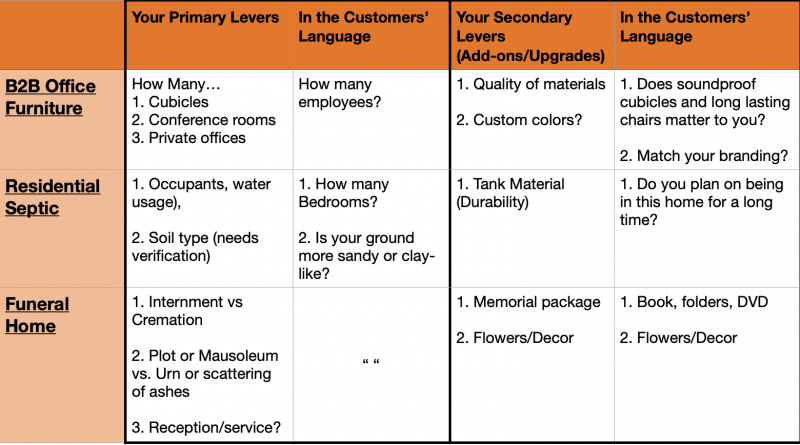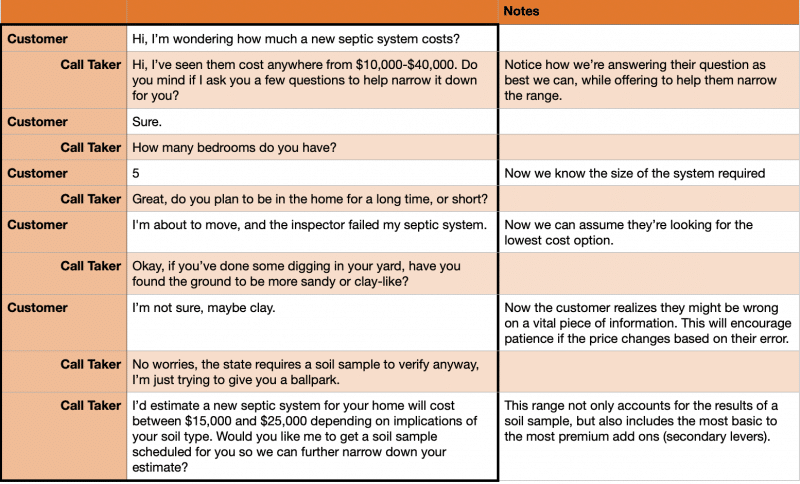If you’ve debated whether to make your pricing publicly available on your website, you’re not alone. This is a particularly daunting question for businesses with complex pricing structures. But here’s the truth, both B2B and B2C buyers aim to be at least 70% confident in their buying decision before they pick up the phone or inquire on a website. This means when we require them to “Call for an estimate”, it’s likely to lead to frustration and they’ll likely look for their answers elsewhere.
Let’s dive deeper into why posting pricing online, even if complex, can be a game-changer and how to do it effectively.
Common Objections to Putting Price on the Website
Commoditization:
Some business owners don’t publish pricing because they want their customers and competitors to see them as a brand, not a commodity. But, let’s think like your customer.
If your customer needs:
- A Toilet replaced
- Taxes submitted
- Cremation service
- HVAC installed
- Or insurance for their business…
Do they see the product/service as a commodity (anyone can do it) or highly specialized?
If they see it as a commodity but you treat the pricing as “highly specialized”, it easily comes across as:
- You don’t have enough experience to know ballpark pricing
- You’re trying to complicate it to take advantage of the customer.
What many forget is a brand can sell commodities. Commodities are easy for the customer to understand and purchase.
Bond with the customer before they need what you offer, then make your offering as simple as possible.
Complexity:
Another reason business owners don’t publish pricing is they feel it’s too complex. “our pricing is complicated and we want our sales reps to educate (sell) them on why we’re the best to provide context (justification)”. But customers want to self-qualify, make a quick decision, and move on. By withholding pricing from them, we create a lack of transparency and distrust with our customers.
So, if you have complex pricing what’s the remedy?
Simplify if you can, estimate if you can’t.
Let me share a real-life example of simplification, my wife and I interviewed contractors for her interior design business. One Contractor, Carlos, noticed that all master bathrooms have the same primary cost levers (vanity, shower, toilet, light fixture, tile). He then changed his pricing model from hourly, to flat rate based on the room, offering an allowance for higher-end finishes. (Ex: He charges the same price for all master bathroom remodels, regardless of size)
Did he lose some projects? Yes.
Did he lose money on some projects? Occasionally.
However, the simplicity in pricing matched how customers wanted to buy AND built trust that the rest of the project would run as simply as his pricing.
Carlos now has a waitlist, consistent subcontractors, and hundreds of 5-star reviews. He made things simple for his customers and they rewarded him for it.
Simplify if you can, estimate if you can’t.
If there’s no way to simplify, you can build trust and convey goodwill by giving them a ballpark price. To do this, start by identifying the primary and secondary levers of your pricing.
- Primary Levers: These are the major factors that influence pricing and are usually non-negotiable for customers. For example, the model of a car would be a primary lever.
- Secondary Levers: These are factors with less smaller on pricing. This could be the trim level in the car example. Important, but typically secondary to the model.
Once you’ve identified your pricing levers, rewrite them in language your customer will understand. Here are three examples I’m helping clients with:

To help you communicate this on your website and across your company, let’s start by playing out what an inbound phone call would look like.

Notice, you don’t need to be narrow in your estimate, just narrow enough to convey transparency, and a desire to help them make the right decision for themselves, (both of which help your brand)
Once you know your levers and script, you can create a pricing video and/or a pricing calculator on your website.
Sharing Pricing
To make complex pricing accessible, consider using video or a calculator on your website:
- Pricing Videos: Keep these short (5-7 minutes max). A pricing video should cover your primary levers and common secondary options with the goal of helping customers understand a general price range. This should also help them feel more equipped to make a buying decision.
- Here’s an example of a pricing video to give customers ballpark pricing
- Pricing Calculators: A calculator allows customers to plug in primary lever inputs and receive an estimate.
- Here’s an example of a pricing calculator by an HVAC company
Benefits of Transparent Pricing
- Brand Alignment: When your website, videos, calculators, and sales team share the same message and pricing, customers are more confident in your brand.
- Optimized Messaging: With consistent messaging across touchpoints, your business becomes less dependent on the skills and knowledge of individual employees.
- Better Leads: By providing answers (especially pricing) upfront, customers who cannot afford you, won’t waste your team’s time.
- Pre-sold Customers: When customers feel informed and empowered, they’ll be more comfortable reaching out and buying, as they’ll feel less risk of being taken advantage of.
Ready to Take the Next Step?
If you have questions about adding pricing on your website or want guidance on effectively communicating with customers, I’ll be happy to help.
- Trust Is Already Deciding Your Prices (You’re Just Not In The Room) - December 24, 2025
- Busy, Booked… and Still Broke - December 16, 2025
- Marketing, Marriage, And The Trust Equation - December 4, 2025

